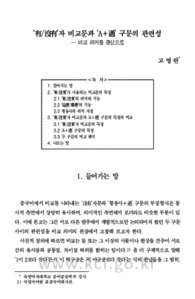

-
미리보기
서지정보
· 발행기관 : 한국중국언어학회
· 수록지 정보 : 중국언어연구 / 75호 / 103 ~ 126페이지
· 저자명 : 고영란
초록
The negative form ‘X沒有(Y)這麼/那麼+A’ of ‘you(有)’ comparative sentence to indicate the comparison and the negative form that takes up a large proportion in ‘A+guo(過)’ structure ‘X沒有(Y)這麼/那麼+A過’ are quite similar on the surface. And both of them indicates the comparative meaning. However, as a result of the study, it was found that there are the following differences.
The former sentence has a characteristic of a typical comparative sentence because it tries to grasp a subject in relation to another subject. However the latter sentence implies that a certain subject has changed its attribute over time, simultaneously implying the present state of the subject.
Therefore the specification of the comparison criterion for the ‘you(有)’ comparative sentence is unrestricted. And since an ideal subject becomes a comparison criterion, the adjective tends to aim for a positive or neutral meaning. On the other hand, the ‘A+guo(過)’ sentence structure does not require a comparison criteria and there is no limit to the semantic qualities of adjectives. However, a small number of irreversible property adjectives cannot appear in this structure because of taking ‘guo(過)’.
Finally, the demonstrative pronoun ‘zheme(這麼)/name(那麼)’ in the two phrases plays an important role in connecting the ideas that are generated after observing the comparative object and the comparative criterion. In the ‘you(有)’ comparative sentence, ‘name(那麼)’ is frequently used. On the other hand, in the ‘A+guo(過)’ structure, ‘zheme(這麼)’ is often observed. In addition, in the ‘A+guo(過)’ structure, ‘zheme(這麼)/name(那麼)’ causes discrepancies in form and meaning, and frequently accompanies ‘conglai(從來)’ and the amount/quantity expressions as additional components.영어초록
The negative form ‘X沒有(Y)這麼/那麼+A’ of ‘you(有)’ comparative sentence to indicate the comparison and the negative form that takes up a large proportion in ‘A+guo(過)’ structure ‘X沒有(Y)這麼/那麼+A過’ are quite similar on the surface. And both of them indicates the comparative meaning. However, as a result of the study, it was found that there are the following differences.
The former sentence has a characteristic of a typical comparative sentence because it tries to grasp a subject in relation to another subject. However the latter sentence implies that a certain subject has changed its attribute over time, simultaneously implying the present state of the subject.
Therefore the specification of the comparison criterion for the ‘you(有)’ comparative sentence is unrestricted. And since an ideal subject becomes a comparison criterion, the adjective tends to aim for a positive or neutral meaning. On the other hand, the ‘A+guo(過)’ sentence structure does not require a comparison criteria and there is no limit to the semantic qualities of adjectives. However, a small number of irreversible property adjectives cannot appear in this structure because of taking ‘guo(過)’.
Finally, the demonstrative pronoun ‘zheme(這麼)/name(那麼)’ in the two phrases plays an important role in connecting the ideas that are generated after observing the comparative object and the comparative criterion. In the ‘you(有)’ comparative sentence, ‘name(那麼)’ is frequently used. On the other hand, in the ‘A+guo(過)’ structure, ‘zheme(這麼)’ is often observed. In addition, in the ‘A+guo(過)’ structure, ‘zheme(這麼)/name(那麼)’ causes discrepancies in form and meaning, and frequently accompanies ‘conglai(從來)’ and the amount/quantity expressions as additional components.참고자료
· 없음태그
-
자주묻는질문의 답변을 확인해 주세요

꼭 알아주세요
-
자료의 정보 및 내용의 진실성에 대하여 해피캠퍼스는 보증하지 않으며, 해당 정보 및 게시물 저작권과 기타 법적 책임은 자료 등록자에게 있습니다.
자료 및 게시물 내용의 불법적 이용, 무단 전재∙배포는 금지되어 있습니다.
저작권침해, 명예훼손 등 분쟁 요소 발견 시 고객센터의 저작권침해 신고센터를 이용해 주시기 바랍니다. -
해피캠퍼스는 구매자와 판매자 모두가 만족하는 서비스가 되도록 노력하고 있으며, 아래의 4가지 자료환불 조건을 꼭 확인해주시기 바랍니다.
파일오류 중복자료 저작권 없음 설명과 실제 내용 불일치 파일의 다운로드가 제대로 되지 않거나 파일형식에 맞는 프로그램으로 정상 작동하지 않는 경우 다른 자료와 70% 이상 내용이 일치하는 경우 (중복임을 확인할 수 있는 근거 필요함) 인터넷의 다른 사이트, 연구기관, 학교, 서적 등의 자료를 도용한 경우 자료의 설명과 실제 자료의 내용이 일치하지 않는 경우
“중국언어연구”의 다른 논문도 확인해 보세요!
-
현대 중국어 항진명제 ‘N+是+N’ 연구 28 페이지
이 논문은 우선 항진명제 ‘N+是+N’의 형식적 특징과 의미적 특징이 무엇인지를 고찰하였다. 다음으로 화용적 특징을 제시하고 이 표현에서 화자가 가장 중점적으로 돌출시키고자 하는 정보력이 높은 초점 성분이 무엇인지 밝혔다. 여기에서 그치지 않고 화자가 의도하는 항진명제의 화용 전략이 무엇인지 살피고, 화자가 의도하는 발화가 어떤 함축의미가 있는 것인지, 청.. -
≪第五游≫古今字訓釋研究 16 페이지
朝鮮時代沈有鎮編著的漢字字書《第五游》中共指認古今字187組。從來源角度看,這些訓釋受到中國歷代古今字訓釋,特別是傳統字書如《說文解字》《正字通》等影響。從價值上看,古今字訓釋是本書重要的體例之一,是說解的有機組成部分,在溝通字際關係之外,還具有說明字義、說明文字構形理據、幫助說解構件和構意、構建互見體例、豐富說解內容等功能。沈有鎮的古今字觀念與中國古代學者的認識一脈相承,都是指同一個詞在不同時間.. -
‘가다’류 동사 ‘去’와 語法化된 ‘往’의 특징 연구 - ‘去’와 ‘往’의 현대적 면모와 특징을 통시적 관점에서 분석 - 26 페이지
본고는 현대 중국어의 어휘와 어법의 특징을 역사적 변천과정의 연구를 통해 밝혀내는 데에 의의를 두었다. 본고는 ‘∼를 향해 가다’류 동사인 ‘如’, ‘适’, ‘之’, ‘往’, ‘去’의 역사적 변천과정에 대해 조사함으로써 古语인 ‘如’, ‘适’, ‘之’, ‘往’의 쇠퇴과정과 ‘往’이 동사에서 개사 및 보어로 어법화(语法化)되는 과정 그리고 新语인 ‘去’의.. -
“X+为”类副词的词汇化现象及“为”的语义功能研究―以“极为”、“最为”、“大为”为例 24 페이지
본 연구는 문법화 이론과 인지언어학의 이론을 바탕으로 하여‘X+爲’류 부사의 어휘화 현상을 고찰하고 ‘爲’의 의미기능을 분석하였다. 본고의 주요 결론을 정리하면 다음과 같다. 동사 ‘爲’의 기본의미는 ‘노동/일하다’이고, 주요 파생의미로는 ‘∼하다’, ‘∼이다’, ‘∼을 ∼으로 삼다/여기다’등이 있다. 재분석, 탈시간화 및 유추 등 문법화 기제는 ‘X+爲’..
문서 초안을 생성해주는 EasyAI

